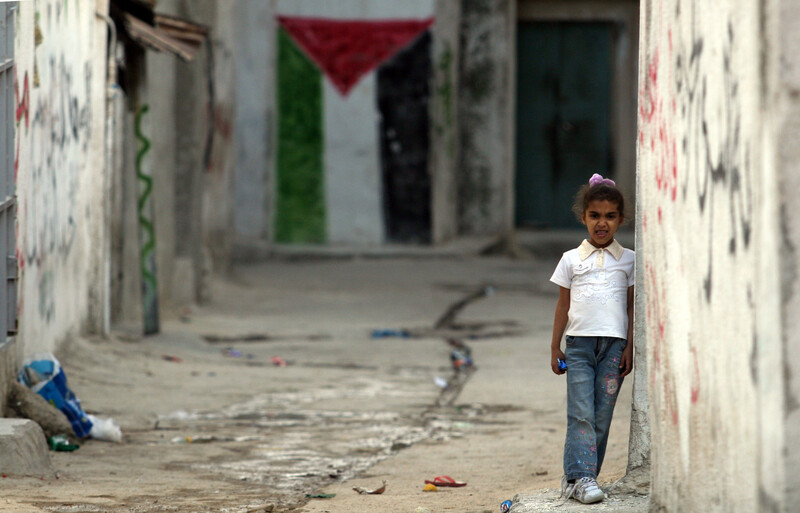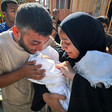Rights and Accountability 16 January 2013

Nearly three-quarters of surveyed Palestinian refugees would leave the camps if they could afford it, BADIL study shows.
APA imagesThe human rights and advocacy group BADIL (badil.org) has published a comprehensive report titled “Survey of Palestinian Refugees and Internally Displaced Persons, 2010-2012,” the result of 10 years of research. The 128-page document by the Palestinian organization is a key resource for anyone wishing to understand the forces which made Palestinians the largest and most long-standing population of forcibly displaced persons in the world, and the conditions in which they live today.
BADIL’s survey is comprehensive, tracing the ongoing forced dispersal of Palestinians from their homeland during the last century — since the British Mandate of Palestine; the ethnic cleansing of Palestine in 1948; Israel’s military rule inside the areas claimed as a Jewish state between 1950-1964; the 1967 War; and Israel’s subsequent regime of occupation, apartheid and colonization in the West Bank and Gaza Strip.
“At the end of 2011, there were at least 7.4 million displaced Palestinians representing 66 percent of the entire Palestinian population (11.2 million) worldwide,” according to BADIL (p. xvii).
The vast majority of Palestinian refugees (5.8 million) are those who were forced from their lands during the 1948 ethnic cleansing and their descendants. Of these, 4.8 million are registered with the UN agency for Palestine refugees (UNRWA). A further million Palestinians are refugees as a result of the 1967 War and there are more than half a million internally displaced Palestinians on both side of the Green Line (the 1949 armistice line marking the boundary between Israel and the occupied West Bank).
BADIL adds: “69 percent of registered refugees do not live in camps and 31 percent of UNRWA-registered refugees live in camps or 25.6 percent of the total Palestinian refugee population (registered and unregistered). Approximately 60 percent of registered refugees live in Arab host countries.”
Most registered refugees lived in Jordan (40 percent) or in the occupied West Bank and Gaza Strip (42 percent). BADIL finds that “Out of every 100 residents of the Gaza Strip, 58 are refugees, and out of every 100 residents of the West Bank, 42 are refugees.”
Ongoing catastrophe and displacement
The Palestinian refugee population is ever growing, and ongoing human rights and humanitarian catastrophes directly impacting Palestinian refugees — such as Israel’s attacks on Gaza, the disastrous US war and occupation in Iraq and the bloody civil war in Syria — continue to forcibly displace Palestinians. Despite this, there is no meaningful international effort to restore the rights of Palestinian refugees. Instead, UNRWA suffers a shortage of budget and thus has had to significantly reduce services.
Significantly, for its report BADIL surveyed thousands of residents of UNRWA-served Palestinian refugee camps in the West Bank, Gaza Strip, Jordan, Syria and Lebanon. The vast majority — 78 percent — say that UNRWA’s services have decreased over the last three years, and 88 percent say that the cessation of UNRWA’s services or its abolition will harm their living conditions in rights, and one-third of the surveyed refugees stated that UNRWA plays an important role in sustaining the case of Palestinian refugees (p. xvii-xix).
Given the dire situation of Palestine refugees, “the absence of effective protection and lack of adequate humanitarian assistance, as well as in light of the failure of the international community and Oslo peace process,” BADIL emphasizes the need for “a human rights-based approach” towards a “just and lasting peace” (xix) which enfranchises Palestinian refugees and internally displaced Palestinians in the areas of historic Palestine now called Israel.
BADIL offers various practical recommendations towards this end, including the rebuilding of representative structures of the Palestine Liberation Organization, which has been essentially dismantled with the advent of the Palestinian Authority, borne out of the Oslo negotiations of the mid-1990s.
Overlooked history
The report also emphasizes the necessity of “studying and addressing the root causes of the ongoing forcible displacement of Palestinians by Israel” (xxi). A succinct overview (p. xxiii) of these root causes of the contemporary crisis is worthy of being read by even those very knowledgeable of the history.
The overview shows that the forcible mass displacement of Palestinians has been going on long before the 1947-1949 Nakba or “catastrophe” — the term Palestinians use for the violent displacement of “750,000 to 900,000 Palestinians (55 to 66 percent of the total Palestinian population at the time) amidst 70 massacres and other atrocities (p. xxv).
During the British Mandate of Palestine, from 1922 til the end of 1947 when the UN recommended the partition of Palestine into two states, “an estimated 100–150,000 Palestinians — nearly one-tenth of the Palestinian Arab population — was expelled, denationalized or forced to leave their homes. Tens of thousands of Palestinians were internally displaced as a result of Zionist colonisation, the eviction of tenant farmers and punitive home demolitions by the British administration.”
BADIL identifies another period of forcible mass displacement of Palestinians that is often overlooked. Following the 1948 war, Israel established a military regime “to control the Palestinian population” in the areas conquered by the new state, while “a civilian government governed affairs of the country’s Jewish population” (p. xxvi).
According to the report:
A web of new land laws was adopted to facilitate the expropriation of refugee property and its transfer to the state and the Jewish National Fund (JNF). Between 1949 and 1966, Israel expropriated some 700 km2 of land from Palestinians who remained within the territory of the new state. In this period, Israel displaced 35,000 to 45,000 Palestinians. Tens of thousands of Palestinians lost their homes and lands, the majority during the 1950s. By the mid-1950s, Israeli authorities had expelled 15 percent of the Palestinian population in Israel and approximately 195,000 Palestinians remained.
A further 400,000-450,000 Palestinians in the West Bank and Gaza were displaced during the 1967 War — “half of them (193,500) were refugees of 1948 and displaced for a second time, while 240,000 were displaced from the West Bank and Gaza Strip for the first time” (xxvi). As many as 95 percent of this group of refugees went to Jordan.
Palestinians continue to be forced from their land today as a result of Israel’s policies of occupation, apartheid and colonization — from the uprooting of Bedouin communities in the Naqab to the freezing of family unification applications and the revoking of residency status from Palestinians in Jerusalem.
Zionism necessitates ethnic cleansing
The ongoing displacement of Palestinians from the historic homeland between the river and the sea is no accident of conflict. It is indeed necessary for the “success” of the Zionist colonial project.
“The essence of Israeli Zionism,” finds BADIL, “can be summarized as the creation and fortification of a specific Jewish national identity, the takeover of the maximum amount of Palestinian land, ensuring that the minimum number of non-Jewish persons remains on that land and that the maximum number of Jewish nationals is transfered to it” (p. xiii).
In addition to the “five main periods of forcible displacement” described above, Palestinians are subjected to “a multitude of discriminatory practices and means employed by Israel which seek to influence all aspects of Palestinian life, and which share the same purpose of mass displacement of non-Jews” (p. xxvii).
Need for rights-based resolution
BADIL emphasizes rights-based approaches as a long-term strategy for resolving the Palestinian refugee crisis which has stretched into its sixth decade. The group says that Palestinian refugees’ rights cannot be voided in any “peace” agreement:
The Oslo negotiations [of the 1990s] represent an effort to obtain – based on the unfavorable balance of power – a de facto solution of the refugee question outside the framework of international law and UN resolutions. However, an explicit renunciation of the right of return by the PLO/PA [Palestine Liberation Organization/Palestinian Authority] in a future political agreement with Israel cannot delegitimize the refugee claim, because – according to standards of international law – provisions of a political agreement do not ensure and grant rights equal to or beyond those defined by international law, are illegal and invalid accordingly. (p. xv)
Given the need for a clearly rights-based framework, BADIL has reservations about the United Nations statehood bid undertaken by the Ramallah-based Palestinian leadership last year:
While this bid for recognition aims to ensure the Palestinian right to self-determination within identified borders, it is largely soft in terms of emphasizing Palestinian refugees’ rights, in particular the right of return. Although such softening could be justified by the need to obtain maximum approval from the UNGA [UN General Assembly], it may be considered a continuous failure of the “peace process” as well as the international community to ensure a just solution for Palestinians. (p. xii)
Advocacy
Though the growing boycott, divestment and sanctions movement to hold Israel to account is not discussed in the report, the movement must treat the restoration of refugees’ rights as most urgent.
Here are some highlights from the report which illustrate why:
- “Available data suggests that differences between the Palestinian refugee populations and their non-refugee counterparts are negligible in most Arab host states, with Lebanon constituting the only major exception because of severe restrictions imposed on their civil, social and economic rights” (p. 2).
- “In 2010, 66.4 percent of Palestinian refugees in Lebanon were poor and 6.6 percent were extremely poor. This indicates that almost 160,000 refugees could not meet their basic food and non-food needs, and 16,000 refugees found to be extremely poor did not meet their essential food requirements” (p. 18).
- There are approximately 360,000 internally-displaced Palestinians in Israel. While no data is available specific to this group, “data pertaining to the general Palestinian population serves as an indicator.” Available data regarding Palestinian citizens of Israel shows stark economic inequality: “In 2010, 53.2 percent of Palestinian families in Israel lived under the poverty line compared with 14.3 percent of Jewish families, a difference of 38.9 percent” (p. 18).
- “Protection provided under Arab regional instruments is inconsistent and does not meet international standards, giving rise to secondary forcible displacement of Palestinian refugees in and from these states” (p. 33).
- “No international agency is currently recognized as having a mandate to intervene on behalf of Palestinian refugees to represent their interests in an international forum, or to protect their human rights against infringement by states, or to facilitate and promote rights-based durable solutions to their refugee situation. Palestinian refugees are rendered without the protection mechanisms or guarantees which are accorded to all other refugees worldwide” (p. 40).
- “Israel deliberately obstructs the work of humanitarian personnel in the [occupied West Bank and Gaza Strip], leaving the Palestinian victims, including refugees and IDPs, without basic medical attention, food, and other services in violation of both international human rights and humanitarian law” (p. 50)
- “Figures for Lebanon-based refugees indicate an alarming [school] dropout rate of about 66% percent (about two-thirds), compared to 52% among refugees in the West Bank … More than half of Palestinian refugee students drop out of school due to the difficult economic conditions facing their families” (p. 65).
- “More than half of those surveyed feel that Palestinian refugees face discrimination in employment as well as in social relations. Moreover, more than 45 percent feel prejudice exists in health care services and higher education” (p. 72).
- “the contemporary regime of humanitarian assistance that has developed for Palestinian refugees and [internally displaced persons], not only has come to replace effective efforts to find durable solutions to the plight of Palestine refugees, but has also gradually decreased” (p. 73).
Download the full report: “Survey of Palestinian Refugees and Internally Displaced Persons, 2010-2012” [PDF]





